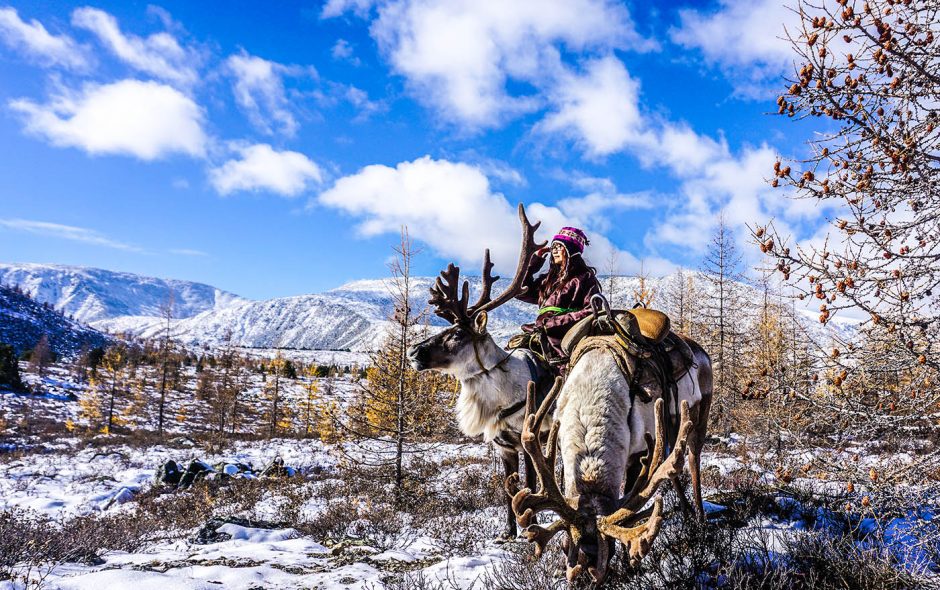Pham Mai Huong reached out to the Tsaatan tribe in the extreme north of Mongolia, where temperatures sometimes drop to -50 degrees Celsius, “a remote place, but a special part of the world” .

Pham Mai Huong was born in 1991, graduated in journalism from the University of Education (Danang University). But she gave up her hourly job to take on a long, challenging journey.
The Tsaatan are the last migratory reindeer herders in Mongolia. That land had vast forests covered with ice and snow, wild wolves howling at night, and rough roads, mud and deserts that could only be crossed by horses.
Huong shared: “I like ancient cultures so I am very curious. Especially after seeing a series of photos about this tribe, I have even more desire to go on the road. After that, I planned to go to Mongolia and gather rare information through backpacking groups.”
 |
|
Mai Huong with a Dukha girl, also known as Tsaatan. |
She brought a luggage weighing 20 kg, despite her lack of information and experience for the trip, she did not find any English articles written by foreigners about this place. Mai Huong’s companion is Agata, a Polish girl whom she met through the Couchsurfing website. Agata is a backpacker who also went to Vietnam to cross Vietnam.
From the Mongolian capital, Ulaabaatar, they took an 18-hour, 700-kilometer, cramped bus filled with goods to Moroon. Then they took the only bus (once every few days) to reach the village of Tsagaanuur – “the most terrifying ride” she had ever taken in her life.
10-seat minivan, but always crammed with 15-16 people, with a bunch of goods, making the seats extremely cramped and stuffy. The distance is 300 km, but it takes 16 hours to arrive, because the road is bumpy and muddy. She vomited throughout the journey, her limbs numb from being unable to move.
 |
|
Baby Tsaatan riding a white reindeer. |
Setting up a tent to spend the night in the snow in the taiga forest is Huong’s most memorable memory. She experienced primitive things that seemed to have disappeared from this face of the earth. Those are the things that still exist in the frozen mountains, the forests or along the rivers that weave in the valleys.
“The night in the taiga was so cold that it was impossible to sleep. For me, it was a terrible cold, extremely haunting. It can penetrate all layers of fabric and soak into the body,” shared Mai Huong.
 |
|
The Dukha survive in -50 degrees Celsius weather in Mongolia. |
The cold, icy weather made the two girls numb. They recklessly decided to bring blankets and pillows to a family’s tent, asking to sleep in a corner of their hut. “That night, I slept in a very warm space, and witnessed the nightlife of the Tsaatan family, with them gathered around the fire, biting pine nuts, listening to them sing and talk. It’s really one of the most beautiful memories I’ve experienced,” said Mai Huong.
The Tsaatan tribe does not know English. Huong and her companions communicate with them using quick drawings on paper, body language, and a few scattered words from a dictionary.
 |
|
The white reindeer is considered sacred to the Tsaatan tribe. |
Before the trip, Mai Huong encountered opposition from her family, and pressure from work, freedom, income… Depressed and bewildered, but as a strong faith, as an understanding, the girl The 25-year-old accepts the arduous and adventurous journey to discover new things about people, the ancient nomadic life, and discover their own strength.
She did not know if she was the first Vietnamese to reach the northernmost region of Mongolia, living with this tribe of reindeer herders. It was important to her to be proud of her own endurance. She said: “I spent four days with them. It will be a time I will never forget.”
Previously, Mai Huong had many long trips, such as exploring the Gobi desert in 12 days, going to Phakding village in Nepal, the Himalayas, the trip from Mui Ne to Ca Mau…
She plans to register as an international volunteer, participate in NGO projects, to explore the local culture while traveling in the most economical and closest way, the most experiential. She also wants to make short films about culture and travel in her own way.
